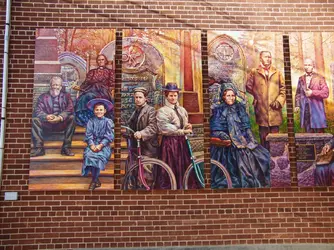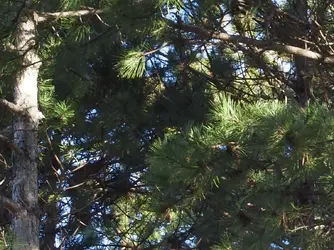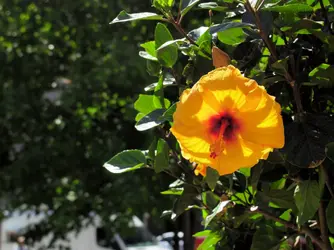I am still exploring the YiM1's new capabilities and testing old capabilities that I did not get around to testing before. In this case I am testing use of adapted lenses, but with a lens I have not tested before. The lens is a Pentax SMC M series 50mm F2.0. This was one of the standard lenses available for the Pentax ME and MX 35mm cameras when they were introduced.
Back in the "old days" when I was using real film cameras, I did not have a special lens testing setup. I did have a target, but I did not have a large wall space to set it up, so I never got around to trying it. What I did was not much different than what I do today. Mainly I point the camera a brick wall to get an idea of some of the more formal characteristics, and then some good colour and black and white subjects. But back then, because film and development cost money, I was very economical in my approach. These days, I take a lot more pictures because I can afford to delete them. Actually, not only can I afford to delete pictures, it is imperative that I do so because it costs me to store them.
But back in the old days, I did not have much opportunity to try out a lot of lenses, so I mainly read the most reliable test reports I could find and saw whatever pictures my friends took and compared them to what I knew.
What I am going to say is my "impression" of the situation back then. There is a good chance that I am wrong about a lot of it. Frankly, I don't really care that much because when it comes down to it, I still cannot afford to buy a whole lot of equipment, and my first problem is to get what I can afford.
Anyway, my "impression" of Pentax back at that period was like this. The screw mount Super Multi-Coat Takumar lenses really were excellent lenses. That was confirmed by every lens test I ever read by Modern Photography and Popular Photography, and a few other magazines I read. The first K-Mount lenses were as good. In fact mostly they were the same lenses in new bodies. And yes, they were new bodies and not just mount changes. The K-Mount was bigger and I think they tended to make the bodies thicker in diameter.
When the M-series lenses came out, Pentax re-designed many of them to be smaller. Here I am going to say something that I know many others will disagree with. I think that many of the smaller Pentax M lenses were not as good as their predecessor models. Probably some might have improved. My "impression" was that colours might have been richer, but they might be softer overall or give away a bit of sharpness or vignetting in the far corners.
It was my "impression" that the older SMC Takumar and Pentax K 55mm F1.8 was a better lens that the M series 50mm F2.0, and moreover, both the 50mm F2 and 50 F1.4 M-series lenses were better than the 40mm F2.8 "Pancake".
Over the last year I have bought both the 50mm F2 and the 40mm F2.8 M series lenses, intending to use them on Micro 4:3. I got the 50mm F2 at about $40 US. The front element is nicked far off axis. I do not think it is affecting the lens performance, but the lens does appear to be softer than a typical SMC Takumar 55mm F1.8 would be. It is not terrible, but it is a bit under-whelming.
Buying the 40mm F2.8 was very annoying. I think I paid about $75 US for it, mainly because Kai had recently posted a YouTube clip about how wonderful 40mm pancake lenses were (this time using a Canon for an example). The old M series 40mm F2.8 is not as good a lens as the later "Limited" lens which would be well worth $75 US (or even much more). But I paid the high price because I think the price for this lens is going to be inflated for quite a while. It is legitimately a rare lens, because most people bought the 50mm F2.0 lens, but optically it is just not "wonderful". I class it as "good". Not better than that because it has severe vignetting when used on a full size sensor (or 35mm film). I bought it as a manual version backup lens for my M4:3 version 42.5mm F1.8 Yi portrait-macro lens.
When the "first colours" of Spring, began to show, I had the 50mm F2.0 lens on a Pentax K100D, but without my monopod and had a terrible time trying to take very small early flowers. I eventually went back to the park with the Yi-M1, first with the Yi 42.5mm F1.8 lens, and then again later with the Yi-M1 with this Pentax 50mm F2.0 lens. The reason for using the 50mm F2.0 lens was because I did not like using manual focus on the Yi 42.5mm lens (which has no focussing control ring), but the Yi-M1 camera does work really well when using adapted, properly designed manual lenses. Also, the slightly longer focal length was a bit easier to work with in a park where I did not want to step into the flower bed to get closer to plants.
[2018-05-12 above 4 paragraphs have minor changes.]
Why is The Yi-M1 So Good For Real Manual Lenses?
The Yi-M1 has really good screen magnification, and in the Version 3.0 - 3.1 firmware that magnification goes beyond 4x to 6x, 8x and 10x. It works like this:
On the back of the camera, the bottom most button is called the "Q" button, and its function varies sometimes. During still and video recording it controls magnification. Each time one clicks that button the screen magnification advances to the next setting and after it reaches 10x, then it re-cycles back to 1x. So the screen magnification cycles like this: (starting from 1x), 2x, 4x, 6x, 8x, 10x, then back to 1x.
[2018-05-12 minor edit for clarification.]
The cycling can be over-ridden at any time by touching the shutter release 1/2 way. The magnification immediately reverts to 1x.
I have found that I generally use 3 quick clicks to get to 6x and do my focussing, and then touch the shutter release back to 1x and compose and take the picture (or abort). I can do this very quickly.
NOTE: Some people prefer "focus peaking" and the Yi-M1 supports this capability. I have tried "focus peaking" on the Yi-M1, the Sony a5000 and the Pentax Q-S1 and on all these cameras I did not find it helpful. In fact, it confuses me and I end up making mistakes.
Before the Yi-M1 with 3.1 firmware, my favorite camera for manual focus was the Pentax Q-S1. Now I prefer the Yi-M1. So the Yi-M1 has my favorite manual focus control, and it also is also arguably, capable of taking the best pictures of any of my cameras, when used this way. My Sony a5000 still has some advantages for still photography, but I won't go into the fine differences right now.
This Set of Pictures:
This set is really just three variations of the same picture and I should start by mentioning that almost all the in-camera JPEG pictures that I have taken with the Yi-M1 have been with AdobeRGB instead of StandardRGB. I made a set of tests (only a couple of pictures of each) comparing StandardRGB against AdobeRGB early when I started testing Firmware version 3.0. What I found was that when using AdobeRGB colour saturation turns out a bit higher. I have not decided that it is necessarily "better" but rather, I am looking at it as a long term experiment. I know that really, AdobeRGB was intended for print output rather than "on screen", but for now I have decided to leave this Yi-M1 as my only AdobeRGB camera. This goes along with the fact that I do not really intend to use it as a still camera anyway. Part of the "test" was to see if it made any difference to videos, and apparently it does not. It seems to only affect still pictures.
[2018-05-12 clarification]
With this set of pictures, two of the files are based on the AdobeRGB output of the in-camera JPEG render. The third image was made from the DNG (raw) file using Corel PaintShop Pro X9, and despite the fact that the colours have been adjusted and "brightened", the Yi AdobeRGB JPEG version is noticeably more saturated.
"P5040013b-rsz1640-C1.jpg"
Partial EXIF (from JPEG)
Date taken 2018-05-04 13:41
Program name ASDK-00141
Dimensions 5184 x 3888
Resolution unit 2
Color representation "Uncalibrated" (AdobeRGB)
F-stop f/0 [probably F16]
Exposure time 1/125 sec.
ISO speed ISO-200
Exposure bias +0.3 step
Focal length 0mm [50mm]
Max aperture 0 [2.0]
Metering mode Center Weighted Average
35mm focal length 0 [100]
[Finish is "Standard"]
- resized version of in-camera JPEG
"P5040013a-Crop01-C1.jpg"
Detail crop from in-camera JPEG
- Start 940,2200 (lower left)
1640 x 1230
"P5040013-2a-SmartFix-C1.jpg"
From DNG:
Temperature 5090
Tint 23
- crop from 950,2210 (almost a match for crop from in-camera JPEG)
- One Step Noise Removal (this function is not defined in my documentation)
- SmartFix:
Brightness
Overall 28
Shadows -50
Highlights 20
Focus 78
Black 12
White 18
NOTE: The recommended "focus" (sharpening) for the DNG without noise removal was "75". Noise removal only increased it to "78". Most images taken on the Yi-M1 using the Yi lenses have used sharpening in the range from "35" to "50". I take this as an indication that this Pentax lens is not as sharp. The only other pictures I have taken with it so far -- on the Pentax K100D, do seem to indicate this as well.
[2018-05-12]
Recently I posted three pictures of flowers taken with the Yi-M1 using the Pentax SMC M-Series 50mm F2.0 lens at:
"
Spring, Finally . . . ."
I did not have a chance to pay attention to these pictures earlier. Looking at them, the lens looks a bit better -- closer to the older 55mm F1.8 . If you look at "P5040057-1c-rsz1240-C1.jpg" in particular, the sharpness and detail level look much better. When I checked my processing
notes I found that the recommended sharpening was only "focus 31" which is roughly in the usual range of my Yi 42.5mm F1.8 lens. So it seems to be about as sharp as that lens. I have a couple of other pictures that show good to excellent performance at around F8, which is also typical of the 50mm F1.4. The following are from my processing notes for that picture:
"P5040057"
- unidentified blue flowers
Partial EXIF from JPEG:
Date taken 2018-05-04 14:03
Program name ASKD-00141
Dimensions 5184 x 3888
Resolution unit 2
Color representation Uncalibrated [the JPEG was AdobeRGB, but
the version I uploaded was from the DNG raw file processed i
Corel PaintShop Pro X9]
F-stop f/0 [I was trying to use between F4.0 and F16.0
and I think this was probably F16.0]
Exposure time 1/250 sec.
ISO speed ISO-200
Exposure bias 0 step
Focal length 0 mm [actually 50mm]
Max aperture 0 [actually F2.0]
Metering mode Center Weighted Average
35mm focal length 0 [actually 100mm]
- Conversion from DNG
Temperature 4282
Tint 21
- SmartFix:
Brightness
Overall 28
Highlights 10
Focus 31
White balance Yes
Black 4
- Vibrancy 20
Which Picture is More "Realistic"?
Actually neither version looks quite the same as I remember the original scene, but I think the AdobeRGB version based images are closer to reality.




































![[No title]](/data/xfmg/thumbnail/33/33028-42917987307dfd2eb37ddccec6dcb655.jpg?1734163036)
![[No title]](/data/xfmg/thumbnail/39/39498-362f11d9bfd0d9e222faa85b38801745.jpg?1734173616)

![[No title]](/data/xfmg/thumbnail/42/42397-30faa170de7ed9be38adf00b9b26a220.jpg?1734176928)


![[No title]](/data/xfmg/thumbnail/37/37105-0f1ebcc8381303893e9a7ce0764e86fe.jpg?1734169829)
![[No title]](/data/xfmg/thumbnail/39/39500-340f9581ccea2902f4cca7c656232f9e.jpg?1734173623)



